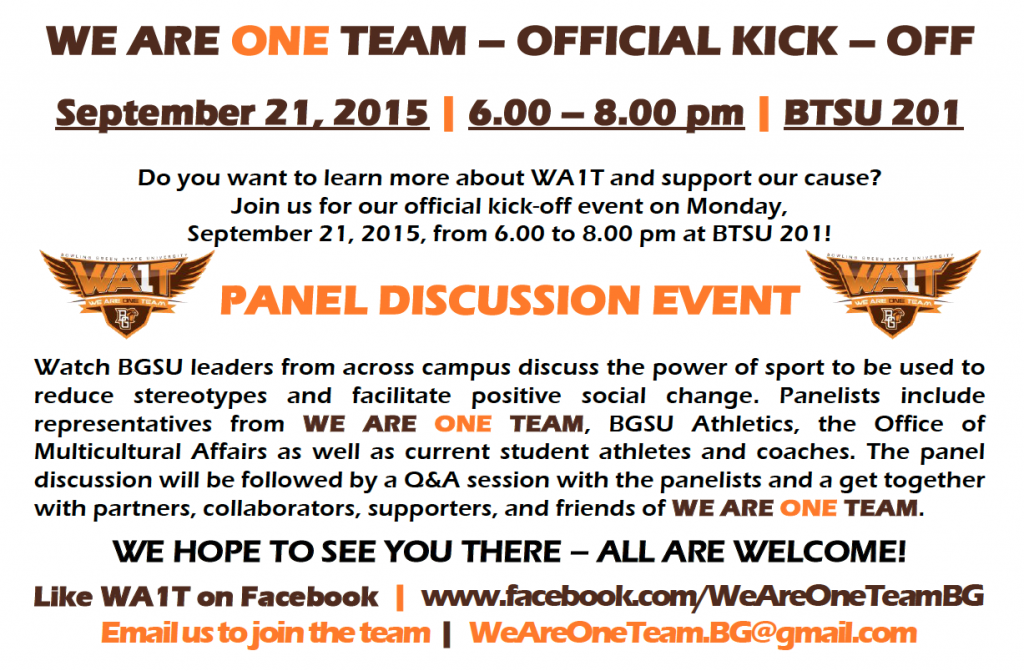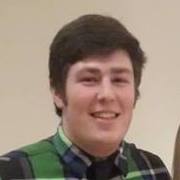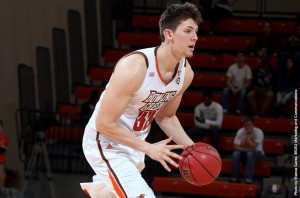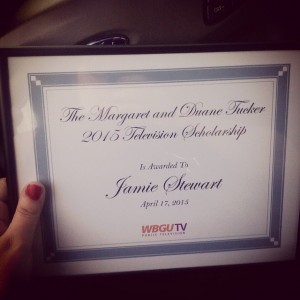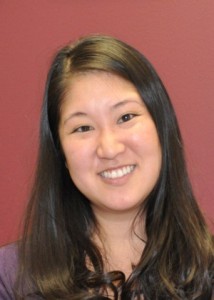The fifth annual Department of Communication Meet & Greet event is scheduled on Friday, October 16, from 2:00-4:00pm in 121 West Hall. Come join us for food, fun, and prizes while networking with alumni, faculty, and other students! RSVP’s are appreciated.
Category Archives: Current Students
“We Are One Team” (WA1T) – Official Kickoff Event
“We Are One Team” (WA1T) is an umbrella initiative for multiple minor projects that promote social justice through sport at BGSU. If you want to learn more about WA1T and support their cause, please join them for their official kick-off event on Monday, September 21, 2015, from 6:00 to 8:00 pm at BTSU 201. The event will be a panel discussion with representatives from WA1T, BGSU Athletics, student athletes, coaches and faculty.
For more information about WA1T please see:
WA1T_CampusFest_General-Flyer
COMM student Drew Ashby-King receives the Board of Trustees’ Leadership Scholarship
Drew Ashby-King, an Honors student who is majoring in communication, was selected to receive one of the 2015-2016 Board of Trustees’ Leadership Scholarships. This highly competitive award recognizes students with a strong record of academic excellence, leadership, and professionalism. From his work on the BG4Unity Service-Learning Project to his leadership roles as a member of the Department of Communication, the Honors College, BGSU’s nationally ranked Cheerleading Team, and BGSU’s Residence Life staff, Drew is an engaged and active member of BGSU’s community.
COMM Major Garrett Mayleben is one of 18 student-athletes named to the 2015 Men’s Basketball Academic All-MAC Team
Read a story by Jason Knavel, Assistant Athletic Director for Athletic Communications at BGSU about freshman Garrett Mayleben being recognized for excelling in athletics and academics.
Valerie Skorupski receives a CURS Grant
Congrats to Valerie Skorupski, who was awarded a $2500 summer grant from the Center for Undergraduate Research and Scholarship (CURS). Valerie will work with her faculty mentor, Dr. Lisa Hanasono, on several research projects related to social media activism and community-building.
Jamie Stewart, a TCOM Undergraduate student and a production assistant at WBGU-TV, received the Tucker 2015 Scholarship
Dr. Lisa Hanasono is to Receive Outstanding New Teacher Award
Please help us congratulate Dr. Lisa Hanasono for winning this year’s Central States Communication Association (CSCA) Outstanding New Teacher Award. The committee selected Dr. Hanasono after carefully considering many qualified candidates for this award. The awards committee was impressed with Dr. Hanasono’s record of teaching. They said “It’s clear your students are lucky to have you!”
Dr. Lisa Hanasono will be officially recognized at the Awards Luncheon at this year’s CSCA conference.
We are very fortunate to have Dr. Lisa Hanasono here at BGSU
SMC Faculty and Graduate Students have Research Accepted in Top Journal
Communication professors Dr. Magsamen-Conrad and Dr. Dowd, and graduate students Shrinkhala Upadhyaya and Claire Youngnyo Joa, have their research paper, Bridging the Divide: Using UTAUT to predict multigenerational tablet adoption practices, accepted in the refereed journal Computers in Human Behavior (impact factor 2.273; 5-year impact factor 3.047).
Their paper examined the “Unified Theory of Acceptance and Use of Technology” (UTAUT) in the context of tablet devices across multiple generations. They tested the four UTAUT determinants, performance expectancy, effort expectancy, social influence, and facilitating conditions, to determine their contributions for predicting behavioral intention to use tablets with age, gender, and user experience as moderators. 899 respondents aged 19-99 completed the survey. They found consistent generational differences in UTAUT determinants, most frequently between the oldest and youngest generations. Effort expectancy and facilitating conditions were the only determinants that positively predicted tablet use intentions after controlling for age, gender, and tablet use. They also discuss the implications of ageism and gender discrimination of technology adoption. Finally, they argue that their findings can be extended to create effective training programs for the teaching, learning, and adoption of new technologies in a variety of organizational settings. Keywords: UTAUT, technology, adoption, age, training, gender
Full text is available here: http://scholarworks.bgsu.edu/smc_pub/37/
Magsamen-Conrad, K., Upadhyaya, S., Youngnyo Joa, C., & Dowd, J. (in press). Bridging the Divide: Using UTAUT to predict multigenerational tablet adoption practices. Computers in Human Behavior.
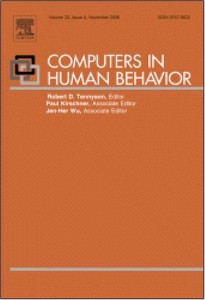
Bob Kline to receive the 2015 President’s Award for Academic Advising
Bob Kline was selected to receive the 2015 President’s Award for Academic Advising! This highly competitive and prestigious award recognizes individuals and units that make significant contributions to support undergraduate students’ educational development and academic success.
From his full time academic advising duties to his extra recruitment and outreach activities, Bob always goes above and beyond to help our students succeed. Please congratulate Bob for receiving this very important honor.
Communication Undergrads Schonhardt, Stinson, Taylor, and Wilson to Present Research at OAGE Conference
Congratulations to undergraduate communication majors Casey Schonhardt, Brandon Stinson, Terry Taylor, and Ladonne Wilson will present their research at the Ohio Association of Gerontology and Education conference this April. Please continue reading for more information of their research projects, completed during independent studys/internship under the direction of Dr. MC.
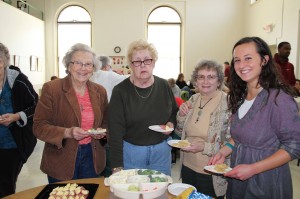
Older Adults and technology: Adoption and acceptance comes from relationships and encouragement from younger generations
Paper to be presented by Casey Schonhardt
Abstract:
As technology progresses, older generations are being given ‘smart’ devices and are adopting these devices to keep up with daily life. Stereotypes posit that the different generational groups perspectives on each other and the digital divide prohibit older generations from adopting new technologies. At the Wood Country Center on Aging located in Bowling Green Ohio, the small group communication class of Bowling Green State University teaches tablet classes once a week to interested older adults. Classes were observed using the STAM (Senior Technology and Acceptance Model), specifically the acceptance phase, over six weeks with narrative and phenomenological research methods. Observing and assisting four small groups teaching older adults different categories of smart tablets, conclusions were made on why older adults accept the technology and even come back for further classes. At the end of the project, it was found that the more positive and genuinely encouraging the students were, the more the older adults consistently attended classes and engaged in learning. Despite rumors of barriers of an age and digital divide, social cues, the relationships made, and the environment play a part in the motivation of technological diffusion in older adult’s daily life.
Introducing and Teaching Information Communication Technology to Senior Citizens
Poster to be presented by Brandon Stinson
Abstract:
This poster examines older adults’ acceptance of information communication technologies (ICTs) as well as strategies for educating older adults about how to use ICTs. Information communication technology has become a key component in our society (Hernandez-Encuentra). For the majority of people it has become a pillar of their everyday lives (Trentin). Today however, many older adults are still reluctant to learn and integrate most information communication technology into their own lives (Gonzalez) as they have for years whenever new technology comes along. Research has shown that several different factors exist to explain why senior citizens do not welcome information communication technology (Loges). Even if they can be convinced to use this technology there are still several factors that can prevent them from both properly and efficiently using it. Researchers have shown that there are numerous methods to teach senior citizens how to properly use information communication technology with varying degrees of success (Jones). This poster will summarize what I have discovered through both compiling information as well as my personal observation with teaching seniors through Dr. Magsamen-Conrad’s Small Group Communication class and an internship at the Wood County Committee on Aging. During Dr. Magsamen-Conrad’s class in the Spring 2014 semester, small groups of five students spent six weeks in a classroom setting teaching older adults how to use tablets. This was the same idea at the internship. From July to August 2014 I taught roughly fifteen older adults how to use tablets in a mostly one on one setting. As older adults continue to become an increasingly larger portion of our population (Lam) it is becoming morevital than ever that they learn and accept information communication technology and become integrated with the rest of society (Feist).
RED: Retired, Engaged, and Determined
Poster to be presented by Terry Taylor
Abstract:
My name is Terry Taylor. I am a senior at Bowling Green State University majoring in Communications with a minor in Geography. Iplan to submit a full paper to be considered for a student award and my professor’s name is Dr. Kate Magsamen-Conrad. I worked very close with Dr.MC through a communications class at the senior center that focused on small group communication. I look into the service that we provided through a series tablet classes held at Bowling Green’s senior center and explore the idea and possibility of expanding the market or services to this age demographic. With the age of retires about to reach and all time high due to the Baby Boomers and the fact that technology is changing and advancing every year, I feel that it is vital to provide similar services as we did in our tablet classes held through the senior center on a wider scale. I conclude with reasoning on why this increased knowledge and interaction through technology is imperative for older adults. My objective is to show a need for the increase in understanding of technology for older adults on a broad scale and to make it aware that this is very beneficial to them in physical, mental, social, and various other forms.
Older Adults Attitudes towards New Communication Technologies
Poster to be presented by Ladonne Wilson
Abstract: As the amount of New Communication Technologies (NCTs) being created increases at an exponential rate it is important to better understand how all portions of our population take advantage of newer NCTs, including older adults. This study sought to better understand older adult’s attitudes towards NCTs as a means of learning and adaption as well as maintaining independence. The researchers argued that older adult’s attitudes toward NCTs have an effect on older adult’s perceived and therefore actual usability. This study was conducted by a communication research methods course at an Ohio public university and it included surveys and interviews of 525 older adults living in the Midwestern United States. The researchers divided the participants into four age groups, Builders, Boomers, Generation Xers and Millennials, and focused primarily on web literacy, performance expectancy, and effort expectancy. The researchers found that there were significant generational differences in attitudes towards NCTs and younger generations were more likely to positively respond to newer NCTs than older generations. The researchers also found that older adults do not experience an immediate attraction to NCT’s unlike younger generations. The researchers posit that these results indicate that must be a greater focus on reducing the deficit between younger and older generations and their respective levels of NCT literacy.


